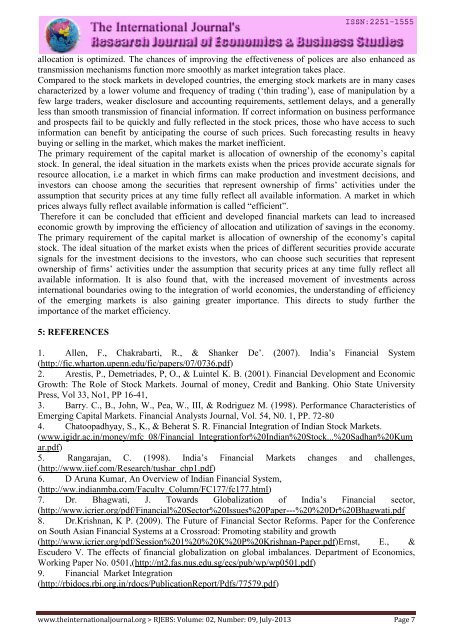Research Journal of Economics & Business Studies - RJEBS - The ...
Research Journal of Economics & Business Studies - RJEBS - The ...
Research Journal of Economics & Business Studies - RJEBS - The ...
You also want an ePaper? Increase the reach of your titles
YUMPU automatically turns print PDFs into web optimized ePapers that Google loves.
allocation is optimized. <strong>The</strong> chances <strong>of</strong> improving the effectiveness <strong>of</strong> polices are also enhanced as<br />
transmission mechanisms function more smoothly as market integration takes place.<br />
Compared to the stock markets in developed countries, the emerging stock markets are in many cases<br />
characterized by a lower volume and frequency <strong>of</strong> trading (‘thin trading’), ease <strong>of</strong> manipulation by a<br />
few large traders, weaker disclosure and accounting requirements, settlement delays, and a generally<br />
less than smooth transmission <strong>of</strong> financial information. If correct information on business performance<br />
and prospects fail to be quickly and fully reflected in the stock prices, those who have access to such<br />
information can benefit by anticipating the course <strong>of</strong> such prices. Such forecasting results in heavy<br />
buying or selling in the market, which makes the market inefficient.<br />
<strong>The</strong> primary requirement <strong>of</strong> the capital market is allocation <strong>of</strong> ownership <strong>of</strong> the economy’s capital<br />
stock. In general, the ideal situation in the markets exists when the prices provide accurate signals for<br />
resource allocation, i.e a market in which firms can make production and investment decisions, and<br />
investors can choose among the securities that represent ownership <strong>of</strong> firms’ activities under the<br />
assumption that security prices at any time fully reflect all available information. A market in which<br />
prices always fully reflect available information is called “efficient”.<br />
<strong>The</strong>refore it can be concluded that efficient and developed financial markets can lead to increased<br />
economic growth by improving the efficiency <strong>of</strong> allocation and utilization <strong>of</strong> savings in the economy.<br />
<strong>The</strong> primary requirement <strong>of</strong> the capital market is allocation <strong>of</strong> ownership <strong>of</strong> the economy’s capital<br />
stock. <strong>The</strong> ideal situation <strong>of</strong> the market exists when the prices <strong>of</strong> different securities provide accurate<br />
signals for the investment decisions to the investors, who can choose such securities that represent<br />
ownership <strong>of</strong> firms’ activities under the assumption that security prices at any time fully reflect all<br />
available information. It is also found that, with the increased movement <strong>of</strong> investments across<br />
international boundaries owing to the integration <strong>of</strong> world economies, the understanding <strong>of</strong> efficiency<br />
<strong>of</strong> the emerging markets is also gaining greater importance. This directs to study further the<br />
importance <strong>of</strong> the market efficiency.<br />
5: REFERENCES<br />
1. Allen, F., Chakrabarti, R., & Shanker De’. (2007). India’s Financial System<br />
(http://fic.wharton.upenn.edu/fic/papers/07/0736.pdf)<br />
2. Arestis, P., Demetriades, P, O., & Luintel K. B. (2001). Financial Development and Economic<br />
Growth: <strong>The</strong> Role <strong>of</strong> Stock Markets. <strong>Journal</strong> <strong>of</strong> money, Credit and Banking. Ohio State University<br />
Press, Vol 33, No1, PP 16-41,<br />
3. Barry. C., B., John, W., Pea, W., III, & Rodriguez M. (1998). Performance Characteristics <strong>of</strong><br />
Emerging Capital Markets. Financial Analysts <strong>Journal</strong>, Vol. 54, N0. 1, PP. 72-80<br />
4. Chatoopadhyay, S., K., & Beherat S. R. Financial Integration <strong>of</strong> Indian Stock Markets.<br />
(www.igidr.ac.in/money/mfc_08/Financial_Integrationfor%20Indian%20Stock...%20Sadhan%20Kum<br />
ar.pdf)<br />
5. Rangarajan, C. (1998). India’s Financial Markets changes and challenges,<br />
(http://www.iief.com/<strong>Research</strong>/tushar_chp1.pdf)<br />
6. D Aruna Kumar, An Overview <strong>of</strong> Indian Financial System,<br />
(http://ww.indianmba.com/Faculty_Column/FC177/fc177.html)<br />
7. Dr. Bhagwati, J. Towards Globalization <strong>of</strong> India’s Financial sector,<br />
(http://www.icrier.org/pdf/Financial%20Sector%20Issues%20Paper---%20%20Dr%20Bhagwati.pdf<br />
8. Dr.Krishnan, K P. (2009). <strong>The</strong> Future <strong>of</strong> Financial Sector Reforms. Paper for the Conference<br />
on South Asian Financial Systems at a Crossroad: Promoting stability and growth<br />
(http://www.icrier.org/pdf/Session%201%20%20K%20P%20Krishnan-Paper.pdf)Ernst, E., &<br />
Escudero V. <strong>The</strong> effects <strong>of</strong> financial globalization on global imbalances. Department <strong>of</strong> <strong>Economics</strong>,<br />
Working Paper No. 0501,(http://nt2.fas.nus.edu.sg/ecs/pub/wp/wp0501.pdf)<br />
9. Financial Market Integration<br />
(http://rbidocs.rbi.org.in/rdocs/PublicationReport/Pdfs/77579.pdf)<br />
www.theinternationaljournal.org > <strong>RJEBS</strong>: Volume: 02, Number: 09, July-2013 Page 7
















